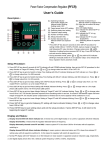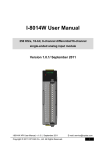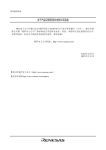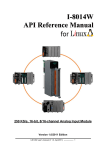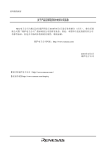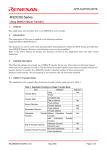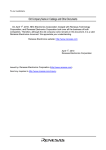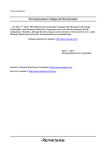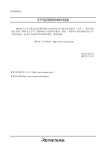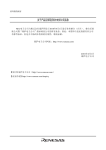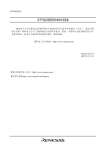Download M16C/Tiny Sensor-less PMSM Driving Platform by 120
Transcript
致尊敬的顾客 关于产品目录等资料中的旧公司名称 NEC电子公司与株式会社瑞萨科技于2010年4月1日进行业务整合(合并),整合后的 新公司暨“瑞萨电子公司”继承两家公司的所有业务。因此,本资料中虽还保留有旧公司 名称等标识,但是并不妨碍本资料的有效性,敬请谅解。 瑞萨电子公司网址:http://www.renesas.com 2010年4月1日 瑞萨电子公司 【发行】瑞萨电子公司(http://www.renesas.com) 【业务咨询】http://www.renesas.com/inquiry Notice 1. 2. 3. 4. 5. 6. 7. All information included in this document is current as of the date this document is issued. Such information, however, is subject to change without any prior notice. Before purchasing or using any Renesas Electronics products listed herein, please confirm the latest product information with a Renesas Electronics sales office. Also, please pay regular and careful attention to additional and different information to be disclosed by Renesas Electronics such as that disclosed through our website. Renesas Electronics does not assume any liability for infringement of patents, copyrights, or other intellectual property rights of third parties by or arising from the use of Renesas Electronics products or technical information described in this document. No license, express, implied or otherwise, is granted hereby under any patents, copyrights or other intellectual property rights of Renesas Electronics or others. You should not alter, modify, copy, or otherwise misappropriate any Renesas Electronics product, whether in whole or in part. Descriptions of circuits, software and other related information in this document are provided only to illustrate the operation of semiconductor products and application examples. You are fully responsible for the incorporation of these circuits, software, and information in the design of your equipment. Renesas Electronics assumes no responsibility for any losses incurred by you or third parties arising from the use of these circuits, software, or information. When exporting the products or technology described in this document, you should comply with the applicable export control laws and regulations and follow the procedures required by such laws and regulations. You should not use Renesas Electronics products or the technology described in this document for any purpose relating to military applications or use by the military, including but not limited to the development of weapons of mass destruction. Renesas Electronics products and technology may not be used for or incorporated into any products or systems whose manufacture, use, or sale is prohibited under any applicable domestic or foreign laws or regulations. Renesas Electronics has used reasonable care in preparing the information included in this document, but Renesas Electronics does not warrant that such information is error free. Renesas Electronics assumes no liability whatsoever for any damages incurred by you resulting from errors in or omissions from the information included herein. Renesas Electronics products are classified according to the following three quality grades: “Standard”, “High Quality”, and “Specific”. The recommended applications for each Renesas Electronics product depends on the product’s quality grade, as indicated below. You must check the quality grade of each Renesas Electronics product before using it in a particular application. You may not use any Renesas Electronics product for any application categorized as “Specific” without the prior written consent of Renesas Electronics. Further, you may not use any Renesas Electronics product for any application for which it is not intended without the prior written consent of Renesas Electronics. Renesas Electronics shall not be in any way liable for any damages or losses incurred by you or third parties arising from the use of any Renesas Electronics product for an application categorized as “Specific” or for which the product is not intended where you have failed to obtain the prior written consent of Renesas Electronics. The quality grade of each Renesas Electronics product is “Standard” unless otherwise expressly specified in a Renesas Electronics data sheets or data books, etc. “Standard”: 8. 9. 10. 11. 12. Computers; office equipment; communications equipment; test and measurement equipment; audio and visual equipment; home electronic appliances; machine tools; personal electronic equipment; and industrial robots. “High Quality”: Transportation equipment (automobiles, trains, ships, etc.); traffic control systems; anti-disaster systems; anticrime systems; safety equipment; and medical equipment not specifically designed for life support. “Specific”: Aircraft; aerospace equipment; submersible repeaters; nuclear reactor control systems; medical equipment or systems for life support (e.g. artificial life support devices or systems), surgical implantations, or healthcare intervention (e.g. excision, etc.), and any other applications or purposes that pose a direct threat to human life. You should use the Renesas Electronics products described in this document within the range specified by Renesas Electronics, especially with respect to the maximum rating, operating supply voltage range, movement power voltage range, heat radiation characteristics, installation and other product characteristics. Renesas Electronics shall have no liability for malfunctions or damages arising out of the use of Renesas Electronics products beyond such specified ranges. Although Renesas Electronics endeavors to improve the quality and reliability of its products, semiconductor products have specific characteristics such as the occurrence of failure at a certain rate and malfunctions under certain use conditions. Further, Renesas Electronics products are not subject to radiation resistance design. Please be sure to implement safety measures to guard them against the possibility of physical injury, and injury or damage caused by fire in the event of the failure of a Renesas Electronics product, such as safety design for hardware and software including but not limited to redundancy, fire control and malfunction prevention, appropriate treatment for aging degradation or any other appropriate measures. Because the evaluation of microcomputer software alone is very difficult, please evaluate the safety of the final products or system manufactured by you. Please contact a Renesas Electronics sales office for details as to environmental matters such as the environmental compatibility of each Renesas Electronics product. Please use Renesas Electronics products in compliance with all applicable laws and regulations that regulate the inclusion or use of controlled substances, including without limitation, the EU RoHS Directive. Renesas Electronics assumes no liability for damages or losses occurring as a result of your noncompliance with applicable laws and regulations. This document may not be reproduced or duplicated, in any form, in whole or in part, without prior written consent of Renesas Electronics. Please contact a Renesas Electronics sales office if you have any questions regarding the information contained in this document or Renesas Electronics products, or if you have any other inquiries. (Note 1) “Renesas Electronics” as used in this document means Renesas Electronics Corporation and also includes its majorityowned subsidiaries. (Note 2) “Renesas Electronics product(s)” means any product developed or manufactured by or for Renesas Electronics. M16C/Tiny Sensor-less PMSM Driving Platform by 120-Degree Trapezoidal Wave Commutation M16C/Tiny User’s Manual RSBJ Published by: Renesas System Solutions (Beijing) Co., Ltd. Beijing Technical Center. Date: March 2008 Version 1.01 Document Number: RSBJEUM0001-0101 Copyright(C): Renesas System Solutions (Beijing) Co., Ltd. Beijing Technical Center. All rights reserved. Trademarks a) General All brand or product names used in this manual are trademarks or registered trademarks of their respective companies or organizations. b) Specific Microsoft Windows is registered trademarks of Microsoft Corporation. Pentium is a registered trademark of Intel. RSBJEUM0001-0101 Rev. 1.01 1 IMPORTANT INFORMATION READ this user’s manual before using this platform board. KEEP the user’s manual handy for future reference. Do not attempt to use the platform board until you fully understand its layout concept. MCU: Throughout this document, the term “Platform” shall be defined as the Renesas M16C/Tiny Sensor-less PMSM Driving Platform by 120-Degree Trapezoidal Wave Commutation, which is for washing machine demo and prototype design reference. Improvement Policy: Renesas System Solutions (Beijing) Co., Ltd. Beijing Technical Center (hereafter collectively referred to as Renesas) pursues a policy of continuing improvement in design, performance, and safety of this evaluation board. Renesas reserves the right to change, wholly or partially, the specifications, design, user’s manual, and other documentation at any time without notice. Target User of the Product: Those who have carefully read and thoroughly understood the information as well as restrictions contained in the user’s manual should only use this product. Do not attempt to use the product until you fully understand its mechanism. Support: Regarding support for the product, no services will be provided. RSBJEUM0001-0101 Rev. 1.01 2 LIMITED WARRANTY Renesas warrants its products to be manufactured in accordance with published specifications and free from defects in material and/or workmanship. The foregoing warranty does not cover damage caused by fair wear and tear, abnormal store condition, incorrect use, accidental misuse, abuse, neglect, corruption, misapplication, addition or modification or by the use with other hardware or software, as the case may be, with which the product is incompatible. No warranty of fitness for a particular purpose is offered. The user assumes the entire risk of using the product. Any liability of Renesas is limited exclusively to the replacement of defective materials or workmanship. DISCLAIMER RENESAS MAKES NO WARRANTIES, EITHER EXPRESS OR IMPLIED, ORAL OR WRITTEN, EXCEPT AS PROVIDED HEREIN, INCLUDING WITHOUT LIMITATION. THEREOF, WARRANTIES AS TO MARKETABILITY, MECRCHANTABILITY, FITNESS FOR ANY PARTICULAR PURPOSE OR USE, OR AGAINST INFRINGEMENT OF ANY PATENT. IN NO EVENT SHALL RENESAS BE LIABLE FOR ANY DIRECT, INCIDENTAL OR CONSEQUENTIAL DAMAGES OF ANY NATURE, OR LOSSES OR EXPENSES RESULTING FROM ANY DEFECTIVE PRODUCT, THE USE OF ANY PRODUCT OR ITS DOCUMENTATION, EVEN IF ADVISED OF THE POSSIBILITY OF SUCH DAMAGES. EXCEPT AS EXPRESSLY STATED OTHERWISE IN THIS WARRANTY, THIS PRODUCT IS SOLD “AS IS”. AND YOU MUST ASSUME ALL RISK FOR THE USE AND RESULTS OBTAINED FROM THE PRODUCT. RSBJEUM0001-0101 Rev. 1.01 3 All Right Reserved: This user’s manual and product are copyrighted and all rights are reserved by Renesas. No part of this user’s manual, all or part, any be reproduced or duplicated in any form, in hardcopy or machine-readable form, by any means available without Renesas‘s prior written consent. Other Important Things to Keep in Mind: 1. Circuitry and other examples described herein are meant merely to indicate the characteristics and performance of Renesas Technology‘s semiconductor products. Renesas assumes no responsibility for any intellectual property claims or other problems that may result from applications based on the examples described herein. 2. No license is granted by implication or otherwise under any patents or other rights of any third party or Renesas. 3. MEDICAL APPLICATIONS: Renesas Technology’s products are not authorized for use in MEDICAL APPLICATIONS without the written consent of the appropriate officer of Renesas Technology (Asia Sales company). Such use includes, but is not limited to, use in life support systems. Buyers of Renesas Technology’s products are requested to notify the relevant Renesas Technology (Asia Sales offices) when planning to use the products in MEDICAL APPLICATIONS. Limited Anticipation of Danger: Renesas cannot anticipate every possible circumstance that might involve a potential hazard. The warnings in this user’s manual and on the product are therefore not all inclusive. Therefore, you must use the product safely at your own risk. RSBJEUM0001-0101 Rev. 1.01 4 PREFACE About this manual This user’s manual discusses how to use three-phase motor control timer function, and a sample application of how to implement position-sensor-less driving of an SPMSM by 120-degree trapezoidal wave commutation, which is a method that makes use of the induced voltage of the motor. This example applies to MCUs in the MC16C/TinyGroup Section 1 About this platform Gives specification on hardware and software Section 2 Description of Software Describes software for motor control Section 3 Finite State Machine of Motor Control Describes state transition for motor control Section 4 Control flow Gives program flowchart. RSBJEUM0001-0101 Rev. 1.01 5 Contents 1. About This Platform ..................................................................................................................................7 1.1 The hardware block diagram ...........................................................................................................7 1.2 The hardware resource assignment table.........................................................................................7 1.3 software specifications ....................................................................................................................8 2 Description of Software..............................................................................................................................9 2.1 Output Pattern Switching ................................................................................................................9 2.2 Detection of Induced Voltages.......................................................................................................11 2.3 Calculation of Actual Rotation Speed ...........................................................................................12 2.4 Calculation of Target Rotation Speed............................................................................................12 2.5 Calculation of PWM Duty Cycle ..................................................................................................13 2.6 List of function modules................................................................................................................14 2.7 List of vrialbles..............................................................................................................................15 2.8 List of Macro definition ................................................................................................................16 2.9 List of constant variable ................................................................................................................16 3 Finite State Machine of Motor Control ....................................................................................................17 3.1 State Discription ............................................................................................................................17 3.2 Condition Description ...................................................................................................................18 4 Control flow .............................................................................................................................................19 4.1 Main processing for sensor-less driving of an SPMSM by 120-degree trapezoidal wave commutation........................................................................................................................................19 4.2 Initialization Processing ................................................................................................................20 4.3 Turn-off Processing .......................................................................................................................21 4.4 PWM Interrupt Processing ............................................................................................................22 4.5 Bootstrap Processing .....................................................................................................................23 4.6Turn-on Processing.........................................................................................................................24 4.7 TB1 Interrupt Processing...............................................................................................................26 4.8 Stop Check Processing ..................................................................................................................26 4.9 Run Processing ..............................................................................................................................27 4.10 PWM Run Calculation Processing ..............................................................................................28 4.11 PWM Duty Calculation Processing .............................................................................................32 4.12 Calculate Rotation Speed Command Processing.........................................................................34 RSBJEUM0001-0101 Rev. 1.01 6 1. About This Platform 1.1 The hardware block diagram M16C/Tiny (SD) P85/nNMI/nSD Three-phase motor control FO (VP) P72/TA1OUT/V (VP) (VN) P73/TA1IN//V (WP) P74/TA2OUT/W (VN) (WN) P75/TA2IN//W (WP) 6 POWER circuit (WN) (UP) P80/TA4OUT/U (UP) (UN) P81/TA4IN//U (UN) (VBUS) P103/AN3 (IBUS) P102/AN2 IPM circuit Potentionmeter VV VU VW PVcc L L 220V AC N N Vbus BUS_IN BUSOUT V U W 3 Motor Speed Command P01/AN01 A/D Conversion (UBEMF) P17/INT5 (WBEMF) P16/INT4 (VBEMF) P15/INT3 Vin Uin Win PVcc Comparator ACCT IBus Induce voltage detect Sample Circuit 1.2 The hardware resource assignment table Used SFR Function Description Used I/O Port TA1 U phase PWM wave P15/ INT3 /IDV V phase induced voltage detection TA2 V phase PWM wave P16/ INT4 /IDW W phase induced voltage detection TA4 W phase PWM wave P17/ INT5 /IDU U phase induced voltage detection TB1 50us cycle inquiry P01/AN01 TB2 Carrier wave cycle control P102/AN2 P103/AN3 P72/V Rotation Speed Command Bus current sample Bus voltage sample V phase voltage P73/ V V phase voltage P74/W W phase voltage P75/ W RSBJEUM0001-0101 Rev. 1.01 Function Description W phase voltage P80/U U phase voltage P81/ U U phase voltage 7 1.3 software specifications Motor type permanent magnet synchronous motor(PMSM) Numbers of pole pairs 2 Control method 120-degree commutation using trapezoidal waves Motor Position Detection Detected by three phase induced voltage of motor Carrier Frequency 5kHz Range of Rotation Speed Command Single Direction 1000rpm to 7200 rpm Error detection The Fo signal (forced shut-down signal) of the IPM is input to the NMI pin of the MCU. Thus, if the Fo signal goes low, the three-phase output is forcibly stopped and the three-phase output pins are placed in the high-impedance state. RSBJEUM0001-0101 Rev. 1.01 8 2 Description of Software 2.1 Output Pattern Switching Pattern 5 Pattern 0 Pattern 1 Pattern 2 Pattern 3 1 U-BEMF Pattern 4 Pattern 5 4 0 3 V-BEMF Zero-crossing 2 W-BEMF 5 Up Un Vp Vn Wp Wn Switch the output pattern 30 degree after the zero-crossing of the induced voltage Calcultation the actual rotation speed from intervals between zero-crossings of the induced voltages Figure 3.1.1 Time Charting RSBJEUM0001-0101 Rev. 1.01 9 VCC Up Vp Wp Un Vn Wn GND Figure 3.1.2 Three-phase IGBT inverter circuit In the 120 degree trapezoidal communication mode, three phase IGBT circuit turn-on sequence is UpWn→WnVp→VpUn→UnWp→WpVn→VnUp, two IGBT are conducted every 60 electrical degrees. Accordingly, PWM wave have 6 output pattern switching. It is shown as the figure 3.1.1 and figure 3.1.2 Output pattern is switched when motor rotor angles 60 electrical degree every time. Zero-crossings of the induced voltages is at the mid of each output pattern (30 electrical degree). In this program, the function of output pattern switching is carried out by PFCR register of M16C62A. It can control each bit in the PFCi (i=0 to 5) to enable each one of three-phase PWM output pins. When setting the PFCi (i=0 to 5) to “0”, three-phase PWM output pin functions act as I/O port and can output “H” level state and “L” level state. In order to outputting PWM wave when motor rotor angles 360 electrical degrees, PFCR register should be set based the following table. Wn Wp Vn Vp Un Up X X PFC5 PFC4 PFC3 PFC2 PFC1 PFC0 Pattern 0 0 0 0 0 0 0 0 1 Pattern 1 0 0 1 0 0 0 0 0 Pattern 2 0 0 0 0 0 1 0 0 Pattern 3 0 0 0 0 0 0 1 0 Pattern 4 0 0 0 1 0 0 0 0 Pattern 5 0 0 0 0 1 0 0 0 Table 3.1.1 PFCR correspond to different output pattern The three-phase PWM output pins have three states, PWM wave, “H” and “L”, the output states depend on PFCR register, Pi register and PDi register. The output states table is shown on Table 3.1.2. RSBJEUM0001-0101 Rev. 1.01 10 PFCi PDi Pi Output 0 1 0 “L” 0 1 1 “H” 1 X X PWM Table 3.1.2 three states of output pin 2.2 Detection of Induced Voltages Induced voltage U Vbus/2 V Vbus/2 W Vbus/2 30 dgr Comparator Output Signal 30 dgr Switching output pattern U Zero-crossing of induced voltage V W Figure 3.1.3 Detection of zero-crossing of induced voltage and comparator output The output pattern of the MCU depends on position information of induced voltages. The voltages output by the inverter are compared with half the bus voltage, and the results are fed to the MCU. The following table shows the connection between MCU pins and induced voltage signals. Input pin BEMF signal P15 / INT3 V_BEMF P16 / INT 4 W_BEMF P17 / INT5 U_BEMF Table 3.1.3 the connection of input pin and induce voltage RSBJEUM0001-0101 Rev. 1.01 11 In our program, when motor mode changes into turnon mode, TB1 interrupt is enabled, after the next carrier wave cycle interrupt, motor woke mode become run mode. Every 50us, TB1 interrupts. If the TB1 interrupt request bit is set to 1, after another 50us, the TB1 interrupt request bit is still set to 1, the zero-crossing of induced voltages is detected, and it is at the mid-point (30 electrical degrees) of each output pattern. Switching of the output pattern is delayed by 30 electrical degrees from zero-crossing detected. The process avoid occurring wrong pulses to be mistaken the detection of zero-crossing of induced voltages because of motor demagnetization at the point of output pattern switching. The U phase processing is shown as figure 3.1.2 When motor work mode changes into stop mode, tb1s is set to “0”, TB1 interrupt stops but interrupt enable is still open. The detection of induced voltage is shown as figure 3.1.1 2.3 Calculation of Actual Rotation Speed The actual rotation speed is calculated by interval between two zero-crossings of induced voltages. The interval comprises certain carrier wave cycle pulses. In the PWM mode, 6 intervals are passed every 360 electrical degree. So if counting the carrier wave pulses every a rotate, the actual rotation speed can be calculated by the following formula. Actual rotation speed= 2π × 5kHz Zero − crossing interval × 6 (3.3.1) In the actual programming, the method of lookup table can be used. Given an array of zero-crossing interval pulses, the corresponding actual rotation speed can be calculated based the above formula. A zero-crossing interval pulses is subtracted 13, the corresponding actual rotation speed can be looked up using the sequence number of array. 2.4 Calculation of Target Rotation Speed The target rotation speed is brought towards the current rotation speed command at a rate of 0.5 rad/s every certain interval until target rotation speed is approach to the rotation speed command. If knowing current target rotation speed, the carrier wave cycle pulses between intervals of zero-crossings can be calculated using the above formula. RSBJEUM0001-0101 Rev. 1.01 12 2.5 Calculation of PWM Duty Cycle Sawtooth Wave modulation TB2 TAi Slow Fast Output Figure 3.1.4 Relationship between PWM Duty Cycle and Rotation Speed Command PWM duty cycle depends on counting values of TAi. The actual rotation speed is proportion to PWM duty cycle, the bigger is PWM duty cycle, the faster is the actual rotation speed. In the course of approaching rotation speed command, the carrier wave cycle pulses can be acquired by target rotation speed every time. Every result is saved a 1dimension array including 12 data units. Then 12 elements are added to calculate average value, a current carrier wave pulses between zero-crossings can be gotten. According to formula 3.3.1, the current actual rotation speed will be gotten. Consequently, the PWM duty cycle is changed according to the conditions given below. Condition Amount of change Target rotation speed > Actual rotation speed + ∆ duty Target rotation speed > Actual rotation speed - ∆ duty RSBJEUM0001-0101 Rev. 1.01 13 2.6 List of function modules Module name Label name Input Output Description Motor control main Main_PWM_120slc20_PFCR( ) —— Main processing PWMInitial( ) —— Set initial values for AD processing Initialization processing conversion, zero-crossing detection ,and three phase PWM PWM interrupt —— PWMInt( ) processing Turn off processing Call the turnoff, bootstrap, turnon and run processing —— TurnoffPWM( ) Turns off the three pahse PWM outputs and checks whether to proceed to startup operation Turn on Processing —— TurnonPWM( ) Performs startup operation and check run mode switch Bootstrap processing —— BootstrapPWM ( ) Charging for 3-phase IGBT circuit TB1 int processing —— TB1Int ( ) Performs 50us timer inquiry and detect induced voltage Run —— RunPWM ( ) Normal PWM operation Processing Run calculation processing —— Cal PwmRun ( ) processing PWM duty calculation and Output pattern switching —— CalPWMDuty ( ) processing Stop check processing Calculates actual rotation speed and PWM duty UNIT_16 Stop StopCheck( ) check result Calculate Rotation Performs sensor-less control CalSpeedCnd( ) Speed Command RSBJEUM0001-0101 Rev. 1.01 Check whether the processing is stopped by a rotation speed command or an error UINT_16 UNIT_16 Convert AD value to rotation Ad rotation speed command Input Value speed command 14 2.7 List of vrialbles Item Label Data Type Resolution Stop state s_StopMode UINT_16 2^0 Output state g_OutputMode UINT_8 2^0 Output angle g_MotTheta UINT_16 2^11 Startup control counter Target rotation speed calculation counter Rotation speed command s_StartCnt UINT_16 2^0 s_TargetCnt UINT_16 2^0 g_SpeedCnd UINT_16 2^1 Target rotation speed g_SpeedTgt UINT_16 2^1 Actual rotation speed Zero-crossings interval counter g_SpeedAct UINT_16 2^1 s_DltCnt UINT_16 2^0 Delay time counter for switching to the next output pattern s_ReloadCnt UINT_16 2^0 output pattern g_Stage UINT_16 2^0 Next output Pattern s_ReloadStg UINT_16 2^0 PWM duty clcye g_PwmDuty UINT_16 2^13 Bootstrap charge delay counter s_BootstpCnt UINT_16 2^0 Bootstrap charge Step counter Current zero-crossings interval counter Former zero-crossings interval counter Zero-crossing interval array s_BootstpStep UINT_8 2^0 g_DltCntRef UINT_16 2^0 g_PreDltCnt UINT_16 2^0 g_DltCntArray[ 12] g_AvrDltCnt UINT_16 2^0 UINT_16 2^0 s_IntCnt UINT_16 2^0 s_ADSpeed UINT_16 2^12 Detect two INTi interrupts for induced voltage Change AD value into rotation speed s_ADSum UINT_32 2^12 16 times AD value sum s_CalCnt UINT_8 2^0 Calculate Average zero-crossing interval pulse External Interrupt counter AD rotation speed command AD rotation speed sum zero-crossing interval array pointer Description Operation mode Counter used to provide the period (2ms) of target rotation speed calculation. ADC input rpm = SpeedCnd /2^1/(2p)/ number of pole pairs×60 The value changed toward the rotation speed command value at a rate of 0.5 rad per 2 ms. Detect from the zero-crossing interval of the induced voltages Counter that measures the interval between zero-crossings (60°). Counter clock period is the carrier period. Counter used to provide a time period from a pattern switching until detection of induced voltage zero-crossings is enabled. Counter clock period is the carrier period Current output pattern Next pattern that is determined based on the induced-voltage zero-crossing detection. A period delay for charging for every IGBT RSBJEUM0001-0101 Rev. 1.01 Three-phase IGBT circuit bootstrap Save 12 times zero-crossing interval pulses average zero-crossing 15 interval pulse AD sample interval g_swtime UINT_16 2^0 Sample once every 16 carrier wave interrupt Induced voltage detection disable time counter g_ChkOnCnt UINT_16 2^0 Counter used to provide a time delay for detect a induced voltage zero-crossing. 2.8 List of Macro definition Macro name Macro value Resolution Description M_CTRL_TS 6711 2^25 Control cycle 0.0002* 2^25 M_K_SPEED_AD_REF 6032 2^12 A-D conversion ratio (240*2*pi/1024)* 2^12 M_Sft_SPEED_AD_RE 11 M_Start_Hz 419 2^1 Carrier wave cycle 5k, startup rotation speed M_Sft_TURNON_MODE 15 2^0 M_TURNON_MODE_TIM 1500 2^0 Start up time M_THETA_60DEG 2145 2^11 Pi/3* 2^11 M_THETA_360DEG 12868 2^11 2*Pi*2^11 M_CARR_CNT 4000 2^0 Carrier wave cycle is 5k M_TURNOFF 0 2^0 Turnoff work mode M_BOOTSTRAP 1 2^0 Bootstrap work mode M_TURNON 2 2^0 Turnon work mode M_RUN 3 2^0 Run work mode M_INI_DUTY_120 1600 2^15 Initial PWM duty M_MIN_DUTY_120 328 2^15 Min PWM duty ( 0.01*2^15 ) M_MAX_DUTY_120 29488 2^15 Max PWM duty ( 0.9*2^15 ) M_BOOT_DUTY_120 3276 2^15 Bootstrap PWM duty M_Sft_DUTY_120_TIME 15 2^0 M_BOOTSTRAPSTEP 3 E (0.08*2^15) ( 0.1*2^15 ) Bootstrap mode step 2.9 List of constant variable Item Label Data Type Output pattern switching table Zero-crossing interval counter table PFCRTbl[ ] UINT_8 Comprise 6 output pattern PWM wave Tgt_Dlt_Conv[ ] UINT_8 Convert target rotation speed to Description zero-crossing interval pulse Actual rotation speed table Dlt_Act _Conv[ ] PFCR output table for bootstrap mode PFCRTblBoot[ ] UINT_8 Convert zero-crossing interval pulse to actual rotation speed RSBJEUM0001-0101 Rev. 1.01 UINT_8 Include three elements for three phase IGBT circuit charging 16 3 Finite State Machine of Motor Control The state of motor control can be shown by finite state machine (FSM). The following figure is the FSM of BLDC in this software. It concludes four states, the states can be switched to other states under the certain conditions. 1 Trunoff Mode 4 2 Bootstrap Mode 3 Trunon Mode 9 5 10 Run Mode 11 8 6 7 3.1 State Discription 1. Turnoff mode expresses that the rotation speed command from A/D converts is 0, and MCU will not output PWM wave. Under this mode, if rotation speed command from A/D converts is not equal to zero, motor work mode changes into bootstrap mode, the target rotation speed and actual rotation are set to the minimum rotation speed, 1000rpm. 2. Bootstrap mode indicate that under the condition of single power supply for IPM module, bootstrap circuit finish the function of charging for upper arm IGBT of 3 phase IGBT circuit. This method is implemented by MCU outputting bootstrap-duty PWM wave. In order to prove to enough charging time of upper arm IGBT, the bootstrap mode last certain time. When three phase IGBT circuit bootstrap mode is finished, the motor work mode changes into turnon mode, otherwise the bootstrap mode is continue. When no rotation speed command is detected or three phase motor output control timer is disabled, the motor work mode come back turnoff mode. 3. Turnon mode points motor starts to run while MCU outputs initial-duty PWM wave. Output pattern switching is forcibly implemented by controlling PWM duty changing amount to calculate motor rotation angle. Passing 1500 carrier wave cycle interrupt, motor work mode changes into Run mode, or it will continue turnon mode. When no rotation speed command is detected or three phase motor output control timer is disabled, the motor work mode come back turnoff mode. 4. Run mode indicates that motor works normally while MCU outputs PWM wave by inputting certain rotation speed command. And the rotation speed command is synchronous to rotate magnetic field frequency, so zero-crossing of induced voltage can be detected accurately to decide to output pattern stwiching by 50us timer interrupt. When no rotation speed command is detected or three phase motor output control timer is RSBJEUM0001-0101 Rev. 1.01 17 disabled, the motor work mode come back turnoff mode. No intervals of zero-crossing of induced voltages are detected when counter of zero-crossing interval exceeds certain values, the motor work mode change into turnon mode. 3.2 Condition Description Condition number Description ① Rotation speed command is not equal to zero ② The three phase IGBT charging process is over ③ Motor rotation speed is synchronous to rotate magnetic field frequency after passing some carrier wave cycle interrupts ④ No rotation speed command ⑤ Rotation speed command is equal to zero or three phase motor output control timer ⑥ disable ⑦ ⑧ No intervals of zero-crossing of induced voltages are detected ⑨ The three phase IGBT charging process is not over ⑩ Don’t satisfied condition No.3 and No.6 11 Always acquire accurate motor position information RSBJEUM0001-0101 Rev. 1.01 18 4 Control flow 4.1 Main processing for sensor-less driving of an SPMSM by 120-degree trapezoidal wave commutation. Main Set local variable ad_input=0x0000 Set local variable Ad_speed PWMInitial processing ad_input = 0x03ff&AD1 CalSpeedCnd processing Ad_speed is current calculate rotation speed No Ad_speed< M_Start_Hz? Yes Rotation speed command = 0 Rotation speed command = Ad_speed RTS RSBJEUM0001-0101 Rev. 1.01 19 4.2 Initialization Processing PWMInitial g_OutputMode =Turnoff mode g_Mottheta=0 s_StopMode =1 g_SpeedCnd=0 Set initial values for induced voltage inputs INT4 interrupt control register = 0x00; INT3 interrupt control register = 0x00; INT5 interrupt control register = 0x00; Interrupt request cause select register = 0xF8; // disable external interrupt, set both edge trigger Set three-pahse PWM initial values. ICTB2 = 0x01 //TB2 underflow generate interrupt Protect register = 0x02 INVC0=0x44 //sawtooth modulation mode, no //two active at an instance INVC1=0x20 // disable DTT, active Protect register = 0x00 Protect register = 0x02 TB2SC =0x02 //set three-phase output forcible //cutoff by /SD pin input IDB0 = 0x3f // set 3-phase output buffer register 0 IDB1 = 0x3f // set 3-phase output buffer register 1 Protect register = 0x00 TA1MR = 0x12 //one-shot pulse mode TA2MR = 0x12 //one-shot pulse mode TA4MR = 0x12 //one-shot pulse mode TB2MR = 0x00 //time mode TRGSR |= 0x45 //trigger select register TB2 trigger TB2 =M_CARR_CNT TA4= TA1=TA2 =M_CARR_CNT ((M_INI_DUTY_120 * (SINT_32)M_CARR_CNT) >> 2^15 //Timer B2 interrupt vector setting Timer B2 interrupt control register = 0x04 Count start flag |= 0x96 //timer count start Protect register = 0x02 INVC0 |= 0x08 //output enable Protect register = 0x00 Set A/D conversion initial values A-D control register 0=0x98//fAD/2, Repeat Sweep //mode 0 A-D control register 1=0x2b//Vref connect, AN0 to //AN7 ,10bit A-D control register 2=0x05//Sample&Hold, P0 Enable Interrupts (I falg =1) RTS RSBJEUM0001-0101 Rev. 1.01 20 4.3 Turn-off Processing TurnoffPWM Stop TB1 TA4= TA1=TA2 = M_CARR_CNT -((M_MIN_DUTY_120 * (SINT_32)M_CARR_CNT) >> 2^15 // Set time value IDB0 = 0x3f IDB1 = 0x00 // generate 3-phase PWM Protect register = 0x02 INVC0 |= 0x08 // output enable Protect register = 0x00 p8_0 = INACTIVE_LVL,pd8_0 = 1 p8_1 = INACTIVE_LVL,pd8_1 = 1 p7_2 = INACTIVE_LVL,pd7_2 = 1 p7_3 = INACTIVE_LVL,pd7_3 = 1 p7_4 = INACTIVE_LVL,pd7_4 = 1 p7_5 = INACTIVE_LVL,pd7_5 = 1 TPRC =1// PFCR register wirte enable PFCR =0// not output PWM wave g_SpeedCnd = 0 ? No Yes s_StopMode=0 g_SpeedCnd =0 g_OutputMode =Turnoff mode ? No Yes g_SpeedCnd > 0 ? No Yes g_OutputMode =Bootstrap mode g_MotTheta =0 s_StopMode=1 Startup control counter=0 Actual rotation speed = M_Start_Hz Target rotation speed = M_Start_Hz*2 RTS RSBJEUM0001-0101 Rev. 1.01 21 4.4 PWM Interrupt Processing PWMINT No g_OutputMode = M_TURNOFF ? Yes TurnoffPWM processing No g_OutputMode = M_BOOTSTRAP? Yes BootstrapPWM processing g_OutputMode =M_TURNON ? No Yes TurnonPWM processing g_OutputMode=M_RUN No Yes RunPWM processing RTI RSBJEUM0001-0101 Rev. 1.01 22 4.5 Bootstrap Processing BootstrapPWM IDB0 = 0x3f IDB1 = 0x00 // generate 3-phase PWM p8_0 = INACTIVE_LVL,pd8_0 = 1 p8_1 = INACTIVE_LVL,pd8_1 = 1 p7_2 = INACTIVE_LVL,pd7_2 = 1 p7_3 = INACTIVE_LVL,pd7_3 = 1 p7_4 = INACTIVE_LVL,pd7_4 = 1 p7_5 = INACTIVE_LVL,pd7_5 = 1 s_BootstpStep < 3 ? No Yes TPRC =1 // PFCR register wirte enable PFCR =PFCRTblBoot[s_BootstpStep]// output PWM wave g_OutputMode = Turnon mode s_BootstpStep = 0 s_BootstpCnt = 0 s_BootstpCnt < 400 ? No Yes s_BootstpCnt +1 s_BootstpCn=0 s_BootstpStep+1 Timer value =M_CARR_CNT – ((BootsrapeDuty*(SINT_32)M_CARR_CN T) >>15) Set timer values Timer A4 register = timer value Timer A1 register = timer value Timer A2 register = timer value StopCheck processing Stop Requested ? No Yes g_OutputMode = M_TURNOFF RTS RSBJEUM0001-0101 Rev. 1.01 23 4.6Turn-on Processing TurnonPWM g_PWMDuty=M_INI_PWM_DUTY g_PWMDuty> M_Max_PWM _duty No Yes g_PWMDuty= M_Max_PWM_duty g_PWMDuty< M_Min_PWM_duty No Yes g_PWMDuty= M_Min_PWM_duty g_Stage = g_MotTheta/ 60 degree IDB0 = 0x3f IDB1 = 0x00 // generate 3-phase PWM PFCR = PFCRTbl [g_Stage] Timer value =M_CARR_CNT – ((g_PWMDuty*(SINT_32)M_CARR_CNT) >>15) Set timer values Timer A4 register = timer value Timer A1 register = timer value Timer A2 register = timer value Rotation speed command >0? No Yes g_MotTheta = M_Start_Hz+M_Start_Hz× M_CNTL_TS 1 RSBJEUM0001-0101 Rev. 1.01 24 1 g_MotTheta > 360 degree No Yes g_MotTheta -= 360 degree s_StartCnt+1 Exceed Pre-setting start time No Yes g_Stage!=s_ReloadStg? No Yes g_OutputMode = M_Run g_SpeedAct = M_Start_Hz s_ReloadStg=g_Stage s_DltCnt= Tgt_Dlt_Conv[M_Start_Hz/12] s_DltCnt<<=1; s_ReloadCnt=0 s_DltCnt+1 Timer_tb1 processing Clear INTi (i=3 to 5) interrup request bit StopCheck processing Stop Requested ? No Yes g_OutputMode = M_TURNOFF RTS RSBJEUM0001-0101 Rev. 1.01 25 4.7 TB1 Interrupt Processing TB1INT PWM duty calculation processing in Run mode RTI 4.8 Stop Check Processing StopCheck Rotation speed command=0? No Yes Stop requested Three phase motor control timer disable ? No Yes RSBJEUM0001-0101 Rev. 1.01 Stop requested No stop requested RTS RTS 26 4.9 Run Processing RunPWM No g_SpeedTgt > set value? Yes SpdDlyCnt = 300 SpdDlyCnt = 600 IDB0=0x3f IDB1=0x00 Timer value =M_CARR_CNT – ((g_PWMDuty*(SINT_32)M_CAR R_CNT) >>15) Set timer values Timer A4 register = timer value Timer A1 register = timer value Timer A2 register = timer value s_TargetCnt+1 No s_TargetCnt>=s_DlyCnt Yes s_TargetCnt=0 No g_SpeedCnd>g_SpeedTgt ? Yes g_SpeedTgt +1 g_SpeedTgt -1 Stop Check processing Stop Requested ? No Yes g_OutputMode = M_TURNOFF RTS RSBJEUM0001-0101 Rev. 1.01 27 4.10 PWM Run Calculation Processing CalPWMRun No s_DltCnt < preset value? Yes g_OutputMode=M_TURNON g_MotTheta=0 s_DltCnt +1 No idb0 = 0x3f idb1 = 0x3f // stop PWM output pfcr = 0x3f // enable PWM output pins int4ic &= 0x00 int3ic &= 0x00 int5ic &= 0x00// clear interrupt request g_Stage = s_ReloadStg? Yes No g_Stage =0? Yes RTS No (Int3ic!=0) Yes Int_counter+1 Int_counter=2? No Yes CalPWMDuty Processing s_ReloadStg= 1 Int_counter=0 Int3ic=0 Int4ic=0 Int5ic=0 g_Stage =1? No Yes No (Int5ic!=0) Yes Int_counter+1 Int_counter=2? No Yes CalPWMDuty Processing s_ReloadStg= 2 Int_counter=0 Int5ic=0 Int4ic=0 Int3ic=0 1 RSBJEUM0001-0101 Rev. 1.01 2 28 1 2 No g_Stage = 2 ? Yes (Int4ic!=0) No Yes Int_counter+1 Int_counter=2 ? No Yes CalPWMDuty Processing s_ReloadStg= 3 Int_counter=0 Int4ic=0 Int3ic=0 Int5ic=0 No g_Stage =3 ? Yes No (Int3ic!=0) Yes Int_counter+1 No Int_counter=2? Yes CalPWMDuty Processing s_ReloadStg= 3 Int_counter=0 Int3ic=0 Int4ic=0 Int5ic=0 1 RSBJEUM0001-0101 Rev. 1.01 3 29 1 3 No g_Stage = 4 ? Yes (Int5ic!=0) No Yes Int_counter+1 Int_counter=2 ? No Yes CalPWMDuty Processing s_ReloadStg= 5 Int_counter=0 Int5ic=0 Int3ic=0 Int4ic=0 No g_Stage = 5 ? Yes No (Int4ic!=0) Yes Int_counter+1 Int_counter=2 ? No Yes CalPWMDuty Processing s_ReloadStg= 0 Int_counter= 0 Int4ic=0 Int3ic=0 Int5ic=0 s_ReloadCnt >0? No Yes s_ReloadCnt -1 4 RSBJEUM0001-0101 Rev. 1.01 30 4 s_ReloadCnt =0? No Yes g_Stage= s_ReloadStg g_Stage = 0 ? No Yes Output Wn phase PWM wave g_Stage = 1 ? No Yes Output Vp phase PWM wave g_Stage = 2 ? No Yes Output Un phase PWM wave g_Stage = 3 ? No Yes Output Wp phase PWM wave g_Stage = 4 ? Output Vn phase PWM wave g_Stage = 5 ? Output Up phase PWM wave TPRC0=1 PFCR=PFCRTbl[g_Stage] int4ic &= 0x00 int3ic &= 0x00 int5ic &= 0x00 RTS RSBJEUM0001-0101 Rev. 1.01 31 4.11 PWM Duty Calculation Processing CalPWMDuty g_DltCntRef =Tgt_Dlt_Conv[ g_TargetCnt/12] No s_DltCnt < 13? Yes s_DltCnt = 13 g_SpeedAct > certain rotation speed? No Yes CalCnt > 12 ? Yes CalCnt=0 No CalCnt > 12 ? Yes CalCnt=0 g_DltCntArray[CalCnt] = s_DltCnt g_DltCntArray[CalCnt] = s_DltCnt CalCnt+1 CalCnt+1 g_AvrDltCnt=? g_DltCntArray[i] ( i= 0 to CalCnt) g_AvrDltCnt / = 12 s_DltCnt = g_AvrDltCnt g_SpeedAct=Dlt_Act _Conv[s_DltCnt -13 ] 1 RSBJEUM0001-0101 Rev. 1.01 32 1 g_PreDltCnt = s_DltCnt g_ReloadCnt = s_DltCnt >> 1 s_DltCnt = 0 g_SpeedTgt > 0&&g_DltCntRef< g_PreDltCnt No Yes g_PWMDuty + 1 g_SpeedTgt > 0&&g_DltCntRef> g_PreDltCnt No Yes g_PWMDuty - 1 g_PWMDuty >M_Max_PWM _duty? No Yes g_PWMDuty =M_Max_PWM _duty No g_PWMDuty <M_Min_PWM _duty? Yes g_PWMDuty =M_Min_PWM _duty Save current PWM duty and actual rotation speed RTS RSBJEUM0001-0101 Rev. 1.01 33 4.12 Calculate Rotation Speed Command Processing CalSpeedCnd Rotation speed command input value = AD vaule*M_K_SPEED_AD_REF/2^11 s_ADSum+=Rotation speed command input Average calculation counter+1 Average calculation counter>=16 ? No Yes s_ADSpeed=s_ADSum/16 s_ADSum=0 Average calculation counter=0 Return value=s_ADSpeed RTS RSBJEUM0001-0101 Rev. 1.01 34 Notes regarding these materials 1. 2. 3. 4. 5. 6. 7. 8. 9. 10. 11. 12. 13. This document is provided for reference purposes only so that Renesas customers may select the appropriate Renesas products for their use. Renesas neither makes warranties or representations with respect to the accuracy or completeness of the information contained in this document nor grants any license to any intellectual property rights or any other rights of Renesas or any third party with respect to the information in this document. Renesas shall have no liability for damages or infringement of any intellectual property or other rights arising out of the use of any information in this document, including, but not limited to, product data, diagrams, charts, programs, algorithms, and application circuit examples. You should not use the products or the technology described in this document for the purpose of military applications such as the development of weapons of mass destruction or for the purpose of any other military use. When exporting the products or technology described herein, you should follow the applicable export control laws and regulations, and procedures required by such laws and regulations. All information included in this document such as product data, diagrams, charts, programs, algorithms, and application circuit examples, is current as of the date this document is issued. Such information, however, is subject to change without any prior notice. Before purchasing or using any Renesas products listed in this document, please confirm the latest product information with a Renesas sales office. Also, please pay regular and careful attention to additional and different information to be disclosed by Renesas such as that disclosed through our website. (http://www.renesas.com) Renesas has used reasonable care in compiling the information included in this document, but Renesas assumes no liability whatsoever for any damages incurred as a result of errors or omissions in the information included in this document. When using or otherwise relying on the information in this document, you should evaluate the information in light of the total system before deciding about the applicability of such information to the intended application. Renesas makes no representations, warranties or guaranties regarding the suitability of its products for any particular application and specifically disclaims any liability arising out of the application and use of the information in this document or Renesas products. With the exception of products specified by Renesas as suitable for automobile applications, Renesas products are not designed, manufactured or tested for applications or otherwise in systems the failure or malfunction of which may cause a direct threat to human life or create a risk of human injury or which require especially high quality and reliability such as safety systems, or equipment or systems for transportation and traffic, healthcare, combustion control, aerospace and aeronautics, nuclear power, or undersea communication transmission. If you are considering the use of our products for such purposes, please contact a Renesas sales office beforehand. Renesas shall have no liability for damages arising out of the uses set forth above. Notwithstanding the preceding paragraph, you should not use Renesas products for the purposes listed below: (1) artificial life support devices or systems (2) surgical implantations (3) healthcare intervention (e.g., excision, administration of medication, etc.) (4) any other purposes that pose a direct threat to human life Renesas shall have no liability for damages arising out of the uses set forth in the above and purchasers who elect to use Renesas products in any of the foregoing applications shall indemnify and hold harmless Renesas Technology Corp., its affiliated companies and their officers, directors, and employees against any and all damages arising out of such applications. You should use the products described herein within the range specified by Renesas, especially with respect to the maximum rating, operating supply voltage range, movement power voltage range, heat radiation characteristics, installation and other product characteristics. Renesas shall have no liability for malfunctions or damages arising out of the use of Renesas products beyond such specified ranges. Although Renesas endeavors to improve the quality and reliability of its products, IC products have specific characteristics such as the occurrence of failure at a certain rate and malfunctions under certain use conditions. Please be sure to implement safety measures to guard against the possibility of physical injury, and injury or damage caused by fire in the event of the failure of a Renesas product, such as safety design for hardware and software including but not limited to redundancy, fire control and malfunction prevention, appropriate treatment for aging degradation or any other applicable measures. Among others, since the evaluation of microcomputer software alone is very difficult, please evaluate the safety of the final products or system manufactured by you. In case Renesas products listed in this document are detached from the products to which the Renesas products are attached or affixed, the risk of accident such as swallowing by infants and small children is very high. You should implement safety measures so that Renesas products may not be easily detached from your products. Renesas shall have no liability for damages arising out of such detachment. This document may not be reproduced or duplicated, in any form, in whole or in part, without prior written approval from Renesas. Please contact a Renesas sales office if you have any questions regarding the information contained in this document, Renesas semiconductor products, or if you have any other inquiries. RSBJEUM0001-0101 Rev. 1.01 35





































